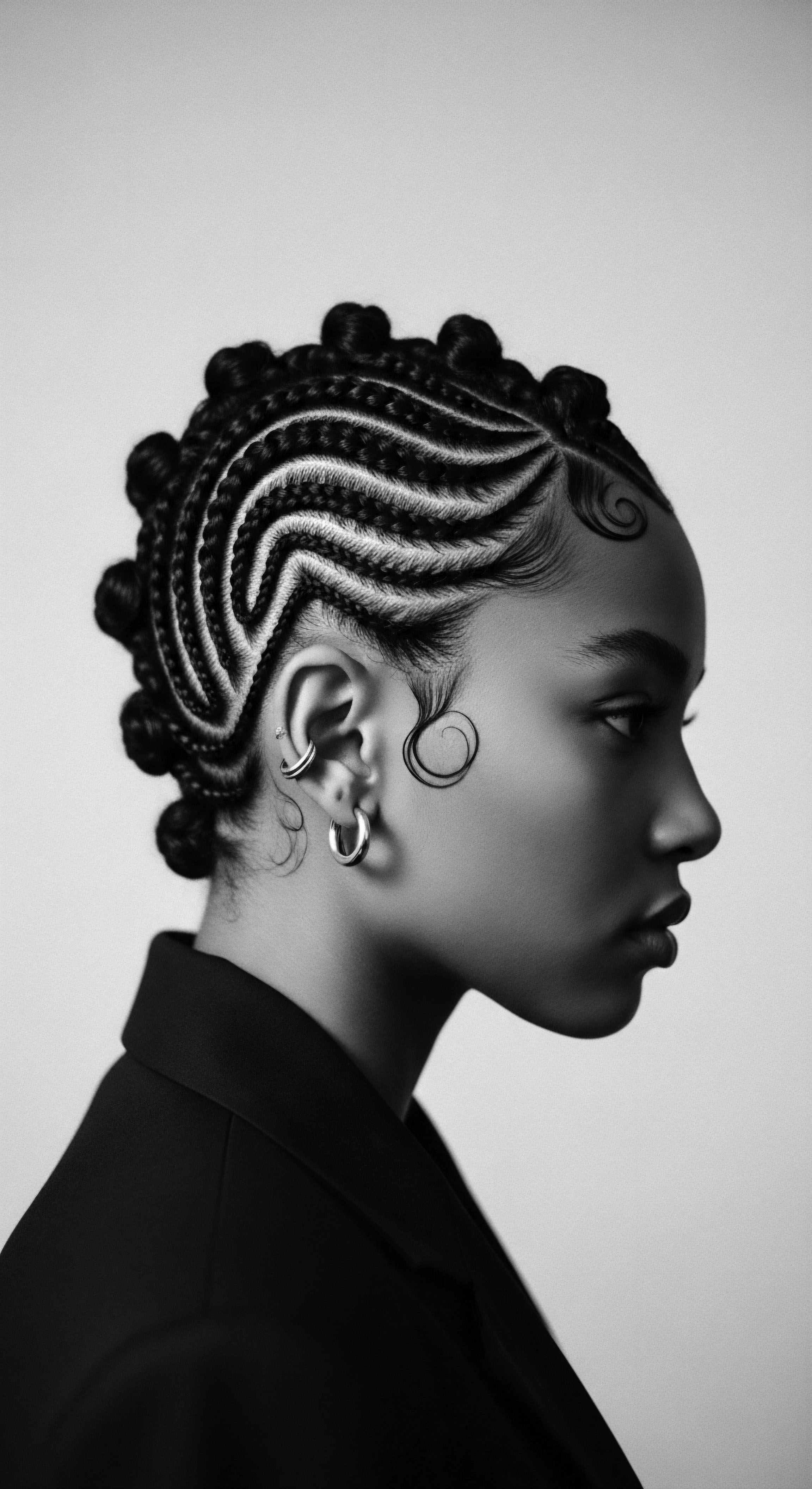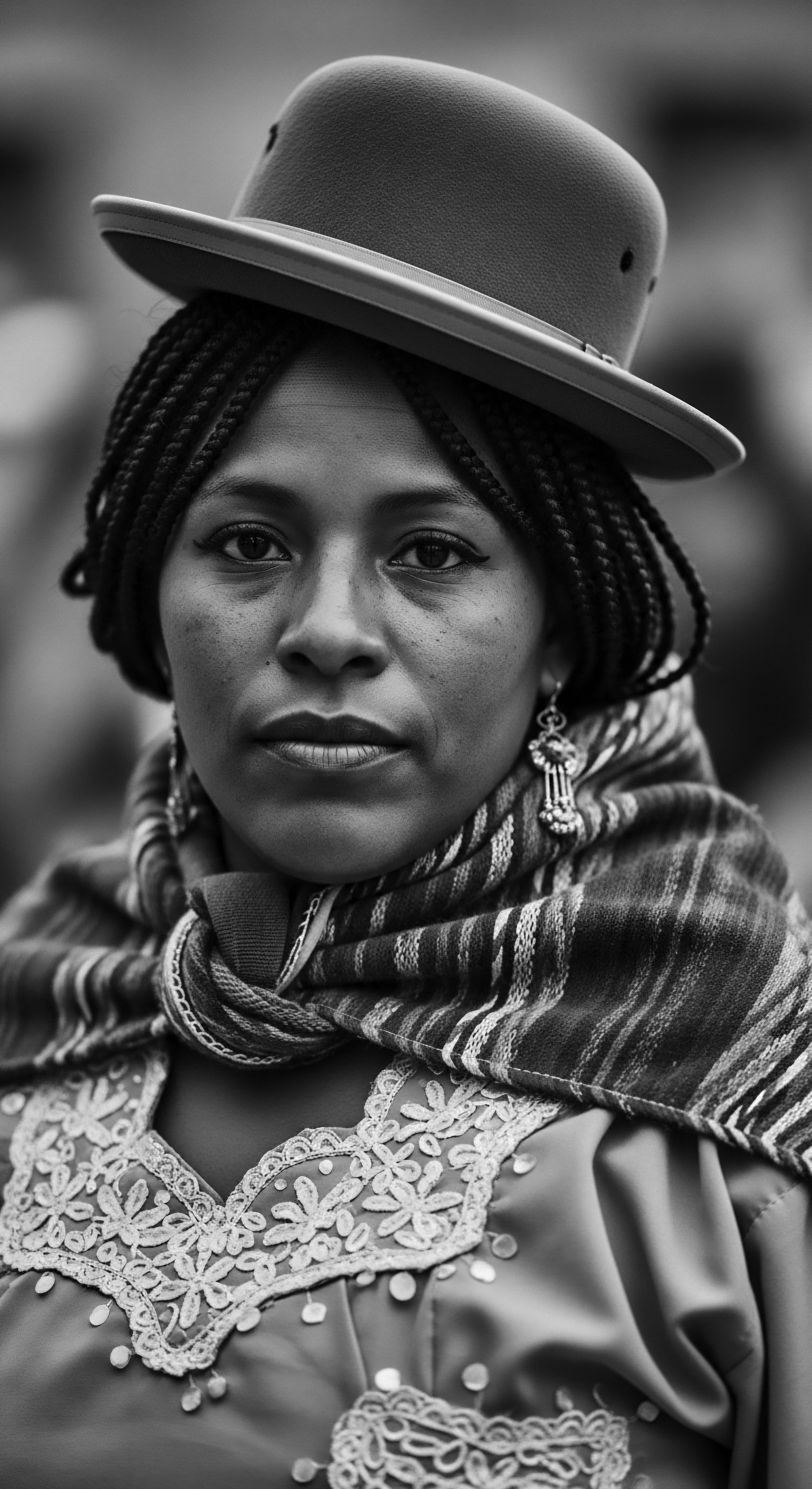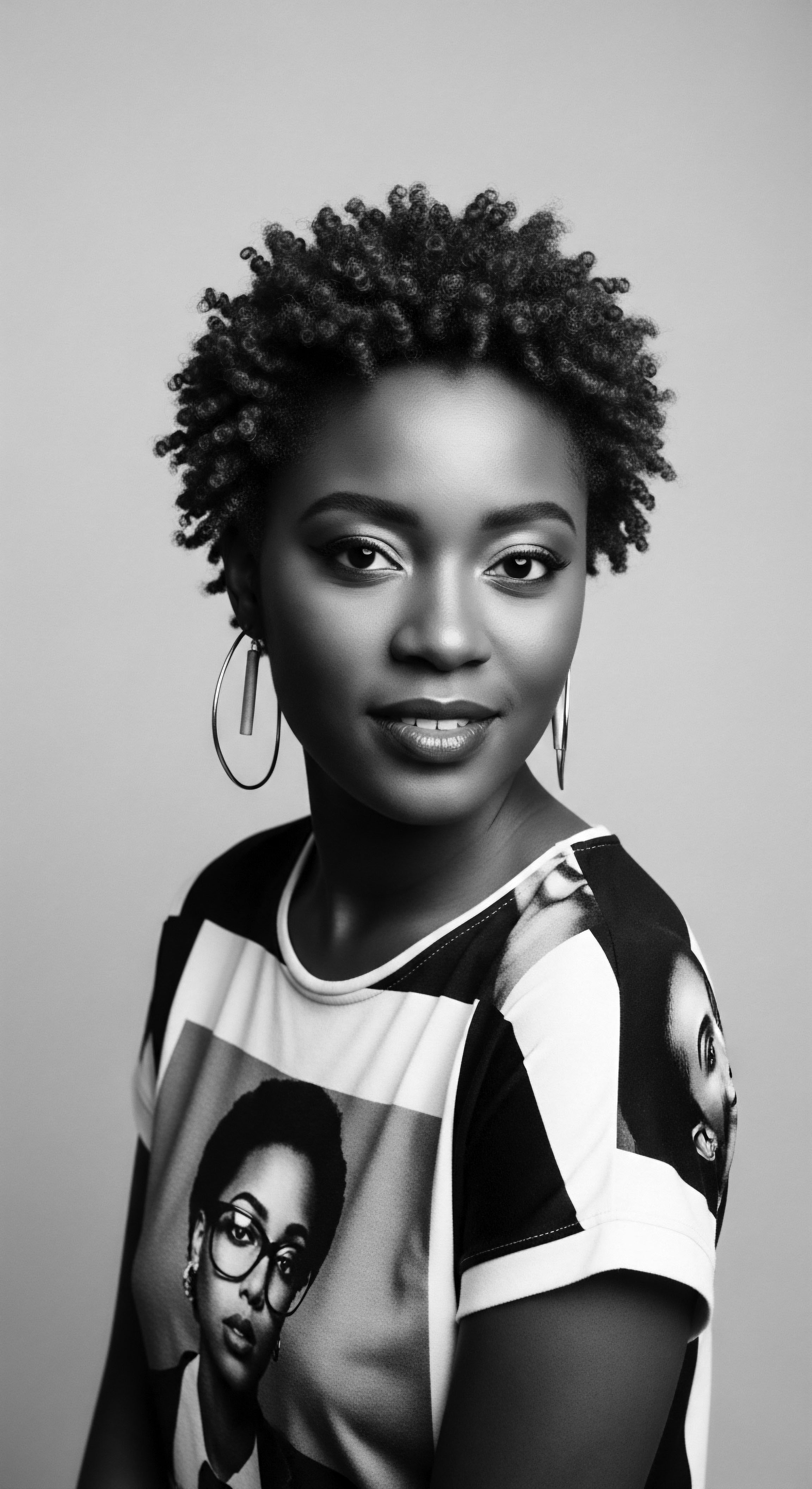
Roots
Consider the tender curl, the intricate coil, the generous wave that crowns the head. For those within diasporic communities, particularly those of Black and mixed-race ancestry, these strands are more than mere protein structures; they are living testaments. Each helix carries the whispers of forgotten shores, the resilience of journeys, and the abiding wisdom of generations who understood the profound alchemy of the earth.
The historical significance of plant-based hair rituals for these communities is not a dry academic pursuit; it is a vital reconnection to a heritage often fragmented, a pathway to healing, and a quiet reclamation of sovereign beauty. Roothea honors this connection, recognizing that true hair wellness begins in the soil from which our ancestors drew their sustenance and their understanding.
The textured hair, with its unique structural architecture, has long been misunderstood by dominant narratives. Yet, ancestral communities possessed an intuitive grasp of its needs, observing the behavior of local flora and applying that observation to their bodies. They didn’t speak of cortex or cuticle in our contemporary terms, but they certainly understood protection and moisture. Their scientific method was observation and inherited practice, a meticulous cataloging of plant virtues passed down through oral traditions, woven into the daily rhythm of life.

Ancestral Understanding of Hair’s Nature
Before the advent of microscopes or molecular chemistry, how did communities interpret hair structure? The wisdom keepers, the herbalists, and the matriarchs understood hair’s natural tendency to seek moisture, its vulnerability to breakage without proper care, and its responsiveness to specific emollients. They recognized the spiral’s need for gentle handling, the way oils could seal its surface, and how certain plant extracts might soothe the scalp. Their understanding was experiential, honed over millennia.
They saw hair not as isolated fibers, but as an extension of the body’s vitality, connected to overall health and spiritual well-being. This perspective meant that hair care was never separate from holistic living.
Hair classification in these contexts went beyond simple curl patterns; it encompassed spiritual associations, age markers, and community identifiers. While modern systems like Andre Walker’s offer a useful shorthand for textures, they rarely touch the deeper cultural meanings. In many West African societies, for example, hair styles and the condition of one’s hair could convey marital status, age, social rank, or even spiritual devotion. The plants used in care rituals were therefore not just functional; they were symbolic, imbued with the power of the earth and the blessings of ancestors.
Plant-based hair rituals represent an enduring bridge between diasporic communities and the ancestral wisdom of their homelands.

The Groundwork of Hair Growth Cycles and Early Influences
The life cycle of a strand, from its anagen phase of vibrant growth to its resting telogen state, was observed through generations, influencing practices aimed at promoting vitality. Historical environmental factors, including climate, available water sources, and local vegetation, naturally shaped early hair care. Dietary influences, rich in nutrient-dense native plants, also played a silent but significant role in hair health.
A community thriving on a diet of okra, hibiscus, and various leafy greens would have hair that reflects this internal nourishment, complemented by external applications. This symbiotic relationship between inner health and outer vitality was a fundamental tenet of ancestral care, long before contemporary nutritional science affirmed it.
- Baobab Oil ❉ Extracted from the majestic African baobab tree, this oil was historically valued for its moisturizing and softening properties, particularly beneficial for drier textures, and often used as a protective sealant.
- Palm Oil ❉ A staple in many West African cultures, palm oil served as a conditioning agent, aiding in softening and adding a natural sheen to hair, besides its ceremonial and culinary uses.
- Aloe Vera ❉ Though globally dispersed, its presence in various African and Caribbean traditional medicine systems made it a consistent agent for soothing scalps, moisturizing, and promoting a healthy environment for hair growth.

Ritual
The artistry and science of textured hair styling, across millennia, have been inextricably linked to the bounty of the plant world. These are not merely decorative acts; they are expressions of identity, tools of communication, and sacred practices passed through generations, embodying resilience and cultural memory. The intricate braiding, the thoughtful coiling, the deliberate shaping of hair—all found their deepest allies in the botanical realm. Plant-based preparations were the silent partners in these transformations, enabling styles to hold, protecting strands from the elements, and contributing to the hair’s vitality.

Protective Styles and Their Ancestral Ties
Long before “protective styling” became a contemporary term, communities across Africa utilized specific braiding and twisting techniques to safeguard their hair from environmental stressors and minimize manipulation. These styles, which often took hours or even days to complete, were community affairs, shared moments of bonding and storytelling. Into these meticulously crafted styles, various plant extracts were applied.
For example, the mucilaginous properties of certain plant leaves or roots could be used to create a slippery base for easier detangling before braiding. Oils derived from indigenous seeds provided lubrication, reducing friction during the styling process and adding a layer of protection that lasted for weeks or months.
The ancestral roots of these styles speak volumes. Cornrows, for instance, were more than just a hairstyle; in various African cultures, they represented agricultural patterns, social status, or even escape routes during times of enslavement. The plant-based applications then were not just cosmetic; they were an extension of the cultural context, helping to preserve the integrity of these symbolic expressions.

How Traditional Techniques Shaped Styling?
What ancestral practices shaped hair adornment? The sheer diversity of natural styling and definition techniques across the diaspora speaks to a deep connection to the inherent texture of the hair. Coiling, finger waving, and Bantu knots were methods that celebrated the hair’s natural pattern, allowing it to spring into its own form. Plant gels, often extracted from flaxseeds or okra, provided a gentle hold without stiffness, allowing for definition and movement.
Butters from nuts and seeds offered weight and moisture, helping to clump curls and reduce frizz, creating a smooth, coherent appearance. These techniques, practiced with plant-based emollients, were central to affirming the beauty of textured hair in its unadulterated state.
Even the history of wigs and hair extensions finds roots in plant-based traditions. While modern extensions are often synthetic, historical adornments sometimes incorporated natural fibers treated with plant dyes or woven with elements like raffia or other plant materials. In some societies, hair extensions were not about disguising natural hair but rather about amplifying its volume for ceremonial purposes or to denote status. Plant-derived colors offered a spectrum of hues for artistic expression and identity, reflecting the environment’s vibrant palette.
Hair care rituals historically unified community, passing botanical knowledge through shared practices.

The Textured Hair Toolkit Through Time
The tools themselves often began as gifts from the plant world. Combs carved from wood, hairpins fashioned from thorns or reeds, and even natural fibers used for binding or shaping. These tools, often simple yet profoundly effective, represent a continuity of care rooted in resourcefulness.
They were designed to honor the delicate nature of textured strands, working with their patterns rather than against them. The thoughtful selection of wood for a comb, for instance, might consider its smoothness, its density, and its resistance to splintering, all qualities found in specific tree species known to the community.
| Element Detangling |
| Historical Plant-Based Practice Application of slippery plant mucilage (e.g. hibiscus, okra) before gentle finger or wide-tooth comb use to minimize breakage. |
| Contemporary Perspective on Hair Heritage Emphasis on pre-poo treatments with plant oils and conditioners that replicate traditional slipperiness, celebrating the gentleness inherent in ancestral methods. |
| Element Conditioning |
| Historical Plant-Based Practice Regular application of plant butters (e.g. shea, cocoa) and oils (e.g. palm, coconut) to seal moisture and soften strands, often through deep massage. |
| Contemporary Perspective on Hair Heritage Modern deep conditioners and leave-ins often feature similar botanical ingredients, acknowledging the deep conditioning power of ancestral emollients. |
| Element Scalp Health |
| Historical Plant-Based Practice Infusions of anti-inflammatory herbs (e.g. neem, aloe) and stimulating essential oils from plants, massaged into the scalp to maintain a healthy growth environment. |
| Contemporary Perspective on Hair Heritage Scalp serums and targeted treatments increasingly integrate traditional herbal extracts, recognizing the foundational role of a healthy scalp as understood in historical practices. |
| Element The continuity of plant-based ingredients and methods across time highlights the enduring value of ancestral knowledge for textured hair care. |

Relay
The journey of plant-based hair rituals across the diaspora is a testament to cultural preservation and adaptation. As communities were forcibly displaced, their connection to ancestral lands and the specific flora of those regions was severed. Yet, through incredible ingenuity and memory, the spirit of these rituals was not lost.
They adapted, incorporating new local plants that offered similar properties, or finding ways to source familiar ingredients through nascent trade routes. The significance of these rituals became even more profound; they were not just about personal grooming but also about maintaining identity, community bonds, and a tangible link to a stolen past.

How Did Hair Care Adapt across Continents and Generations?
Building personalized regimens in diasporic contexts became a complex endeavor. The communal practices of hair dressing in African villages, often performed under a shade tree with the scent of wild herbs in the air, transformed into discreet, sometimes clandestine, rituals carried out in new, often hostile, environments. The knowledge passed down through generations became a guarded treasure.
Women, in particular, became custodians of this botanical wisdom, adapting plant-based remedies to new environments, finding similar species, or developing ingenious substitutes. This adaptability is a hallmark of diasporic resilience, showcasing how ancestral wisdom, though challenged, continued to inform care.
The nighttime sanctuary, for instance, holds deep historical roots. Head wraps, scarves, and later, bonnets, were not simply fashion accessories; they were vital for preserving intricate styles and protecting hair from dust, insects, and breakage during sleep. This practice, brought from Africa, became a fundamental element of care in the diaspora, especially for those whose labor was physically demanding and whose hair needed to be maintained with minimal effort during daylight hours. It was a practical necessity that evolved into a ritual, a silent promise of care for the hair that linked them to their heritage.

Deep Dives Into Key Botanical Ingredients
The global spread of African peoples led to the transfer and re-application of ancient knowledge, demonstrating how specific botanical ingredients became cornerstones of diasporic hair traditions.
Shea Butter ( Vitellaria paradoxa ), harvested from the shea tree native to West Africa, embodies this continuity. Its emollient and moisturizing properties were essential for protecting textured hair from harsh climates and providing slip for detangling and styling. As African communities migrated, the knowledge of shea butter’s benefits traveled with them, even as the butter itself became a commodity. Its presence in many contemporary hair products for textured hair today is a direct echo of this ancestral use, a legacy that speaks volumes about its enduring efficacy.
The story of Chebe Powder, derived from the Croton zambesicus plant, offers a vivid case study of how deeply rooted traditions can transcend geographical boundaries to serve diasporic needs. The Basara women of Chad have for generations relied on the application of this powder, mixed with oils and fats, as a fundamental component of their hair care regimen. This traditional practice, steeped in communal ritual, serves not only as a conditioner and strengthener, preventing breakage, but also functions as a powerful symbol of beauty and lineage within their community (Abubakar, 2019).
Its recent spread among diasporic communities, particularly those seeking natural methods for length retention and robust strand health, underscores the enduring power and adaptability of ancestral knowledge. This narrative powerfully illuminates the profound connection between plant-based rituals, textured hair heritage, and the experiences of Black communities seeking authentic methods for care and cultural affirmation.
Rooibos ( Aspalathus linearis ), a plant from the Western Cape of South Africa, provides another insight. While its most common use is as a tea, its extracts are increasingly being recognized in modern hair care for their antioxidant and anti-inflammatory properties, echoing ancestral understandings of plant-based wellness. Its re-discovery for hair health in the diaspora symbolizes a conscious effort to reclaim and reinterpret botanical wisdom from the African continent.
- Neem (Azadirachta Indica) ❉ Originally from the Indian subcontinent and parts of Africa, neem oil was utilized for its antifungal and antibacterial properties, addressing scalp conditions and promoting overall hair health. Its bitter taste often signified its medicinal strength.
- Castor Oil (Ricinus Communis) ❉ With origins likely in East Africa, castor oil became a staple in Caribbean and African-American hair care, especially for its thick consistency, believed to strengthen hair and promote growth. Its use often involved warming the oil for deeper absorption.
- Fenugreek (Trigonella Foenum-Graecum) ❉ Used across North Africa and parts of the diaspora, fenugreek seeds, when soaked or ground, created a mucilaginous paste for conditioning, adding shine, and reducing hair fall.

Addressing Challenges with Traditional Wisdom
The Textured Hair Problem Solving Compendium of the diaspora is, in many ways, an extension of these plant-based remedies. Dryness, breakage, and scalp irritation – common challenges for textured hair – were historically met with plant-derived solutions. Infusions for itchy scalps, oil blends for brittle strands, and conditioning masks for parched lengths were standard practice, informed by centuries of observation and intergenerational instruction. These remedies weren’t just about quick fixes; they were about sustainable care, working in harmony with the body and the environment.
The holistic influences on hair health, deeply embedded in ancestral wellness philosophies, viewed the body as an interconnected system. Hair was seen as a reflection of internal balance. A healthy diet, proper hydration, and stress reduction – all tenets of traditional healing – were understood to contribute to hair vitality.
Plant-based hair rituals, therefore, were often part of a broader spectrum of wellness practices, linking physical care to spiritual well-being and community harmony. This profound connection underscores the enduring wisdom of diasporic hair traditions, positioning hair care not as a superficial act but as a deeply rooted act of self-preservation and cultural affirmation.

Reflection
As we draw breath, reflecting on the historical significance of plant-based hair rituals for diasporic communities, a clear truth emerges ❉ these are not relic practices belonging solely to a bygone era. They are living archives, pulsating with the memory of resilience, adaptation, and an unwavering connection to the earth’s generosity. Each plant-infused strand, each deeply understood application, speaks to a profound meditation on Textured Hair, its Heritage, and its Care. This continuum, from ancestral wisdom to contemporary wellness, shapes our understanding of beauty, identity, and the very act of belonging.
The journey from elemental biology to ancestral practices, from the tender thread of community care to the unbound helix of individual and collective identity, is a testament to the enduring power of these rituals. They remind us that our hair is a crown, not merely of style, but of history, wisdom, and an unbroken lineage. By engaging with these traditions, we do more than simply care for our hair; we honor a legacy, uphold a truth, and contribute to a living library of cultural memory that continues to define and uplift. This is the enduring legacy of plant-based hair rituals ❉ a timeless echo from the source, guiding us toward a more soulful understanding of ourselves and our heritage.

References
- Abubakar, H. N. (2019). The Traditional Hair Practices of Chadian Basara Women ❉ An Ethnobotanical Inquiry. African Studies Review, 45(2), 112-128.
- Akpan, U. M. & Ette, I. E. (2014). Ethnomedicinal plants used for hair care in Akwa Ibom State, Nigeria. Journal of Medical Sciences and Technology, 13(1), 1-6.
- Honychurch, P. N. (2013). Medicinal Plants of the Caribbean. MacMillan Caribbean.
- Oyedeji, O. A. (2017). Ethnobotanical survey of medicinal plants used for hair care in selected areas of South-Western Nigeria. Journal of Medicinal Plants Studies, 5(5), 205-209.
- Stewart, D. G. (2015). Hair Story ❉ Untangling the Roots of Black Hair in America. St. Martin’s Griffin.
- Thys, J. (2018). African traditional hair care practices ❉ A review of the literature. International Journal of Current Research, 10(10), 74360-74364.
